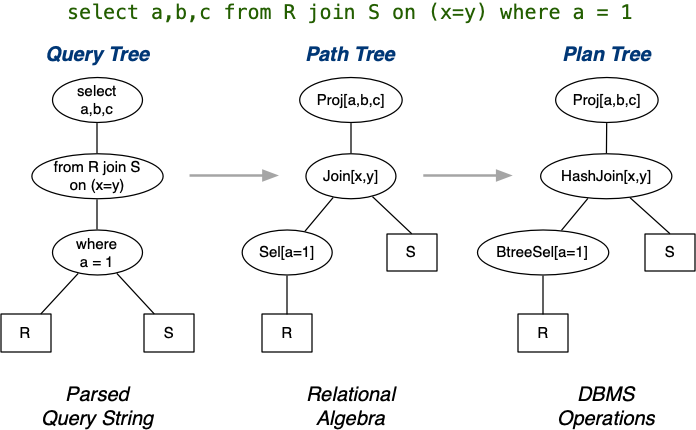Query Optimisation
Overview
The query optimiser:
- Takes RA expression from SQL compiler.
- Produces sequence of RelOps to evaluate the expression.
Optimisers aim to find a good plan, but maybe not optimal.
- Observed query time = planning time + evaluation time.
- Limited planning time means we can’t always find optimal plan.
- Would require exhaustive search of very large search space and need to estimate cost of each (not cheap).
- Instead, do limited search of query plan space (guided by heuristics).
- Quickly choose a reasonably efficient execution plan.
- Limited planning time means we can’t always find optimal plan.
Approaches to Optimisation

Main classes of techniques:
- Algebraic (equivalences, rewriting, heuristics).
- Physical (execution costs, search-based).
- Semantic (application properties, heuristics).
All driven by aim of minimising (or at least reducing) “cost”.
Real query optimisers use a combination of algebraic + physical.
Semantic QO is good idea, but expensive/difficult to implement.
Cost-based Query Optimiser
Approximate algorithm:
# translate SQL query to RAexp.
for # enough transformations RA' of RAexp:
while # more chioces of RelOps:
Plan = {}
i = 0
cost = 0
for nodeE RA_prime: # recursively
ROp = # select RelOP method for e
Plan = Plan.union(ROp)
cost += Cost(ROp) // using child info
if cost < MinCost:
MinCost = cost
BestPlan = Plan
Heuristics: push selections down, consider only left-deep join trees.
Cost Models and Analysis
The cost of evaluating a query is determined by:
- Size of relations (database relations and temporary relations).
- Access mechanisms (indexing, hashing, sorting, join algorithms).
- Size/number of buffers (and replacement strategy).
Analysis of cost involves estimating:
- Size of intermediate results.
- Number of disk reads/writes.
Choosing Access Methods (RelOps)
Performed for each node in RA expression tree.
Inputs:
- Single RA operation (projection, selection, join).
- Information about file organisation, data distribution.
- List of operations available in the database engine.
Outputs:
- Specific DBMS operation to implement this RA operation.
Choosing Selection Methods
σ_{A=c}(R)andRhas index onA==>indexSearch[A=c](R).σ_{A=c}(R)andRis hashed onA==>hashSearch[A=c](R).σ_{A=c}(R)andRis sorted onA==>binarySearch[A=c](R).σ_{A>=c}(R)andRhas clustered index onA==>indexSearch[A=c].σ_{A=c}(R)andRis hashed onA==>linearSearch[A>=c](R).- Hashing doesn’t help here.
Choosing Join Methods
R ⨝ SandRfits in memory buffers ==>bnlJoin(R, S).R ⨝ SandSfits in memory buffers ==>bnlJoin(S, R).R ⨝ SandR, Ssorted on join attribute ==>smJoin(R, S).R ⨝ SandRhas index on join attribute ==>inlJoin(S, R).R ⨝ Sand no indexes or sorting ==>hashJoin(R, S).
PostgreSQL Query Optimisation
